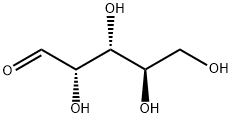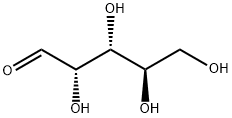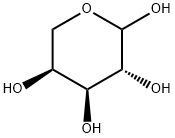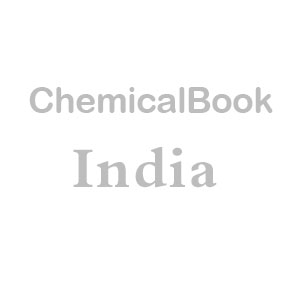DL-Arabinose
- CAS NO.:147-81-9
- Empirical Formula: C5H10O5
- Molecular Weight: 150.13
- MDL number: MFCD00135867
- EINECS: 205-699-8
- SAFETY DATA SHEET (SDS)
- Update Date: 2024-12-18 14:08:52

What is DL-Arabinose?
Chemical properties
white fine crystalline powder
The Uses of DL-Arabinose
DL-Arabinose is used in physicochemical studies to measure properties such as dielectric relaxation. It may be used in chiral separation of sugars. DL-Arabinose, is a building block of polysaccharide (CCPa-1) from fungus Coprinus comatus Gray, which has potential application as natural antitumor agent with immunomodulatory activity. Arabinose is also used as a culture medium for certain bacteria.
The Uses of DL-Arabinose
As culture medium for certain bacteria.
Definition
ChEBI: 2,3,4,5-tetrahydroxypentanal is a pentose, a polyol and a hydroxyaldehyde.
Properties of DL-Arabinose
| Melting point: | 158-160 °C |
| Boiling point: | 415.5±38.0 °C(Predicted) |
| alpha | D12 +173° (6 min) D20 +105.1° (22 hrs c = 3) |
| Density | 1.609 g/cm3(Temp: -5 °C) |
| storage temp. | Inert atmosphere,Room Temperature |
| solubility | Methanol (Slightly, Heated, Sonicated), Water (Slightly) |
| form | Solid |
| pka | 12.46±0.20(Predicted) |
| color | White to Off-White |
| Water Solubility | soluble |
| Merck | 14,761 |
| BRN | 1723086 |
| CAS DataBase Reference | 147-81-9(CAS DataBase Reference) |
| EPA Substance Registry System | Arabinose (147-81-9) |
Safety information for DL-Arabinose
| Signal word | Warning |
| Pictogram(s) |
 Exclamation Mark Irritant GHS07 |
| GHS Hazard Statements |
H319:Serious eye damage/eye irritation |
| Precautionary Statement Codes |
P264:Wash hands thoroughly after handling. P264:Wash skin thouroughly after handling. P280:Wear protective gloves/protective clothing/eye protection/face protection. P305+P351+P338:IF IN EYES: Rinse cautiously with water for several minutes. Remove contact lenses, if present and easy to do. Continuerinsing. P337+P313:IF eye irritation persists: Get medical advice/attention. |
Computed Descriptors for DL-Arabinose
New Products
3-Iodophenylacetic acid 3-Pyridineacetonitrile, α-hydroxy- 2-Propanamine, 1-chloro-, hydrochloride (9CI) 3-(hexyloxy)-4-(pyridin-3-yl)-1,2,5-thiadiazole 2-Hexyn-1-ol Dibenzo-18-crown-6 Nickel(II) perchlorate hexahydrate, 98% 4-Bromophenylacetonitrile, 95% 3-Bromo-4-fluoroaniline, 97% Sodium tetraborate decahydrate, 98% Palladium(II) acetate, trimer, Pd 99% 4-Bromo-2-chlorotoluene, 97% N N Dimethylformamide Dimethyl Acetal (Dmf Dma) 2,3-Dichloro Benzoyl Cyanide [Side Chain] Bis(2-Chloroethyl) Amine Hydrochloride L-Glutamic Acid Diethyl Ester Hydrochloride 5-(Difluoromethoxy)-2-Mercaptobenzimidazole 1-Ethyl-3-(3-Dimethylaminopropyl)-Carbodiimide Hydrochloride [EDC Hcl] 1,4-Napthoquinone Bromoiodomethane Sodium Bicarbonate Methylene Dichloride (MDC) Ethyl Acetate Indole-3-Carbinol (I3C)Related products of tetrahydrofuran








You may like
-
 DL-Arabinose CAS 147-81-9View Details
DL-Arabinose CAS 147-81-9View Details
147-81-9 -
 DL-Arabinose CAS 147-81-9View Details
DL-Arabinose CAS 147-81-9View Details
147-81-9 -
 DL-Arabinose CAS 147-81-9View Details
DL-Arabinose CAS 147-81-9View Details
147-81-9 -
 17604-74-9 3-Pyridineacetonitrile, α-hydroxy- 98+View Details
17604-74-9 3-Pyridineacetonitrile, α-hydroxy- 98+View Details
17604-74-9 -
 Cyclohexane, (2-propynyloxy)- 67967-07-1 98+View Details
Cyclohexane, (2-propynyloxy)- 67967-07-1 98+View Details
67967-07-1 -
 2-Propanamine, 1-chloro-, hydrochloride (9CI) 98+View Details
2-Propanamine, 1-chloro-, hydrochloride (9CI) 98+View Details
5968-21-8 -
 3-Iodophenylacetic acid 1878-69-9 98+View Details
3-Iodophenylacetic acid 1878-69-9 98+View Details
1878-69-9 -
 132945-75-6 (S)-1-Boc-3-methanesulfonyloxy-pyrrolidine 98+View Details
132945-75-6 (S)-1-Boc-3-methanesulfonyloxy-pyrrolidine 98+View Details
132945-75-6
Statement: All products displayed on this website are only used for non medical purposes such as industrial applications or scientific research, and cannot be used for clinical diagnosis or treatment of humans or animals. They are not medicinal or edible.
